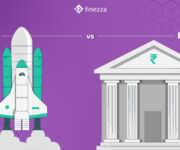Banks, as we see today, are fast leveraging the latest technology to be the best in the financial services market. Traditional banks often deal with too much data and find it difficult to declutter, structure, and analyze the vast database from their legacy systems. They increasingly feel the need to leverage data as efficiently and effectively as possible.
Big Data Lead Transformations for Banks
With the use of big data, banks are capable of guiding the customers and help them navigate through major financial decisions flawlessly. Banks can use customer data to make personalized recommendations for their clients with the use of AI and ML technologies. Furthermore, banks can also get their clients in touch with third-party service providers like utility vendors and expand their areas of functioning. With big data, banks are embracing new digital business models that are inherently diverse in character. Thus, big data technologies are a gateway to a rich range of opportunities that help banks expand beyond their conventional sources of revenue.
Personalised Services
Despite all the buzz around relationship banking, traditional banks are not exactly known for personalized services. To thrive in the modern competitive world, banks need to make the analytics-oriented shift in perspective and craft customer experiences to impress. Banks can use data and analytics to add convenience to banking, making it more personalised for their customers and profitable for themselves. In combination with AI tech, big data can help banks identify customers who are dissatisfied with their services and can help remedy the situations in time. Incorporating customer’s preferences and issuing personalised responses enhance the service quality.
Banks can polish their service at an individual level by recommending economical solutions for handling transactions to customers and offering automation for recurring functions etc. Using big data for their advantage, banks quickly anticipate the needs of their customers and device solutions to cater to them in the most suitable ways, well in advance.
Optimising Consumer Journeys
Modern customers are well-informed decision-makers who make buying decisions and purchases whenever it’s convenient for them. Consequently, they expect seamless experiences across channels from their banks. Banks need to reassess how they understand and connect with customers. Data-driven insights can empower banks to understand each customer’s journey across channels. With digitisation of core banking processes, the footprint has increased and can be efficiently harnessed to derive insights into customer behaviour. Banks need to understand each customer’s journey, and for that, they need to analyse all of their customer data across all channels at the same time. Big data analytics efficiently showcases behaviour patterns that help banks turn leads into customers. Additionally, banks can determine the kind of customer behaviours associated with a high propensity to churn. Banks can proactively engage with customers through marketing efforts in such cases.
Identification of Opportunities for Upselling and Cross-selling
New age banks can expand their business by offering more than just essential banking services to their customers. Cross-selling can be a profitable proposition for growing companies when done right. Offering customers a product or service related to whatever they are already buying through cross-selling is desirable for customer experience. With big data, banks can promote different products and services to their customers based on their individual needs and interests. With big data put to correct use, banks can land new clients and enhance customer lifetime value by pedalling multiple product holdings to different customers. Even upselling banking services and products benefits banks.
Big data-backed cross-selling and upselling not only boost the sales revenue for banks but also help achieve customer service goals. Customers appreciate being informed about new products or services that might better meet their needs or about services that were not offered in the past, which creates value in the present.
From Brokers to Advisors
For most of the developed and developing countries, customers trust banks because of their diligence and the scale at which they function. With the widespread adoption of big data technologies, customers will likely trust banks with their sensitive data for the same reasons. As of present, most tech companies struggle with acquisitions of misuse of consumer data and the absence of transparency about data collection. Working with banks within the strict regulatory environment, it is likely that fewer issues about customer data use and collection with the surface.
However, for banks to become big data giants, they will have to re-evaluate how their clients trust them. Although banking customers have transactional trust in banks, advisory faith is a far-flung goal for most institutions in the country. Bank customers believe that putting their money in the bank account is the safest recluse, which they can access any time without any risk. However, not many customers turn to banks for their recommendations or counsel when it comes to financial decision making. Even B2B players view banks in the capacity of capital providers and financiers but never believe in them as counsellors whose interests align with their own. Banks will have to cultivate the advisory trust by acting as trusted advisors to its customers. The use of customer data to understand and develop appropriate digital business models will help banks change the customer’s perception of them. With big data and the right technology, banks will manage vast volumes of data and be the ‘big data giants’ they intend to be.
To Sum Up
Banks need to embrace big data before it’s too late. The incentive to embrace digitalisation and leverage data resources optimally varies based on regulations and consumer sophistication. If banks fail to keep up with the times in the use of big data, they will continue functioning as capital-intensive and low-return businesses. At the same time, tech companies collaborate with more aggressive traditional competitors to overtake attractive companies for themselves. As of today, only a limited number of traditional banks have turned data, analytics, and AI into their business goals, and still fewer seem to have integrated these capabilities into their core processes. Preliminary data integration leaves many attractive parts of banks’ business vulnerable.
Moving forward, banks will transform into data sources aiding customers in making all kinds of financial decisions. In a quest to ease customer experience, banks are progressing towards a future without any fees, i.e., they earn not from residual income from their customers’ transactions, but from outsourcing their data resources to other service providers. So much so that banks can quickly capitalize on their customer data given that they hone the public’s trust in the institution.
Finezza is one such lending management framework that helps banks and other financial institutions with data-backed risk analytical capabilities. The software itself excels at data extraction accuracy from fields like name, date of birth, and address, etc. easing the paper load off the shoulders of banking officers. It comes with a unique document recognition and data structuring module that can drastically reduce the end to end time used to populate the required fields of a document from 1-2 minutes down to 5-10 seconds, lending greater efficiency to banks. The software tool also aids intelligent debt collection thanks to big data.




[…] mentioning that Cleantech requires data to operate, and it is one area where Fintechs can help. Big data, for example, allows startups to sort through the massive amounts of information and find […]